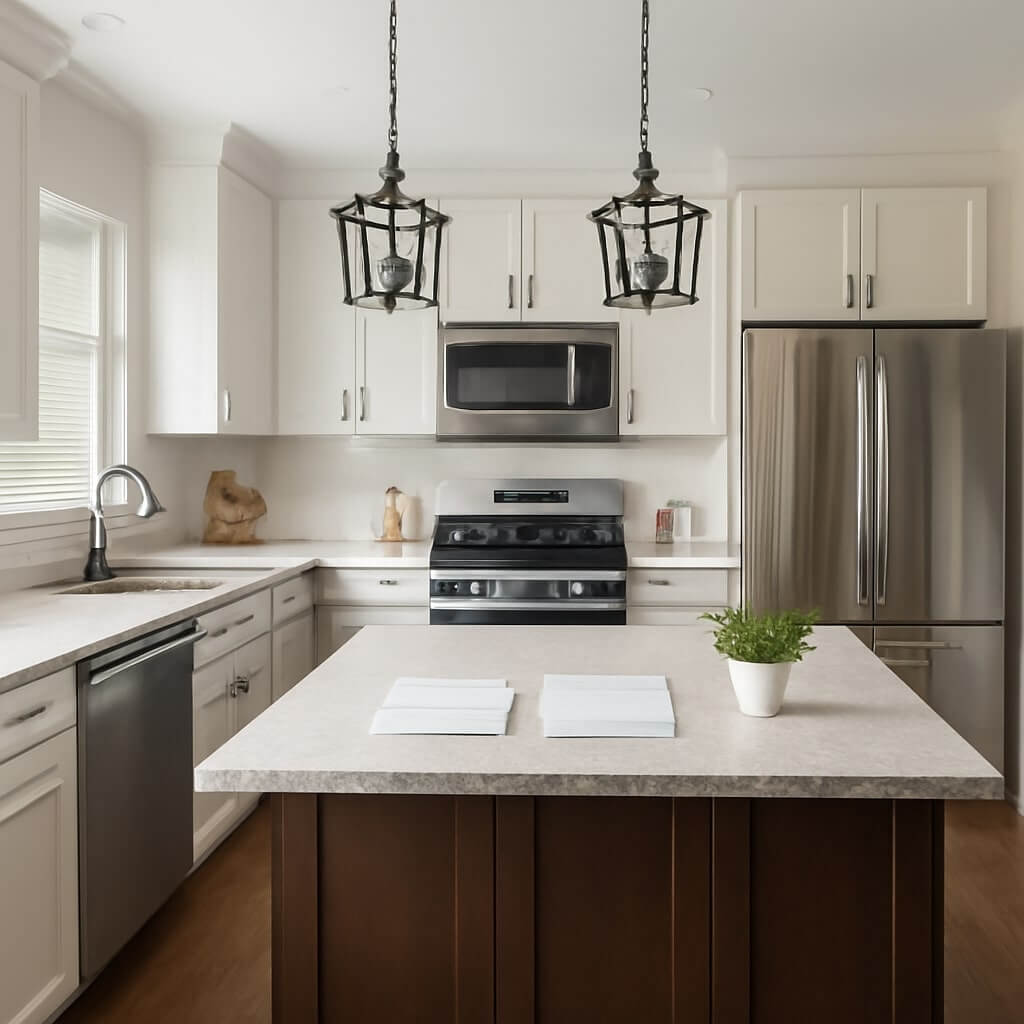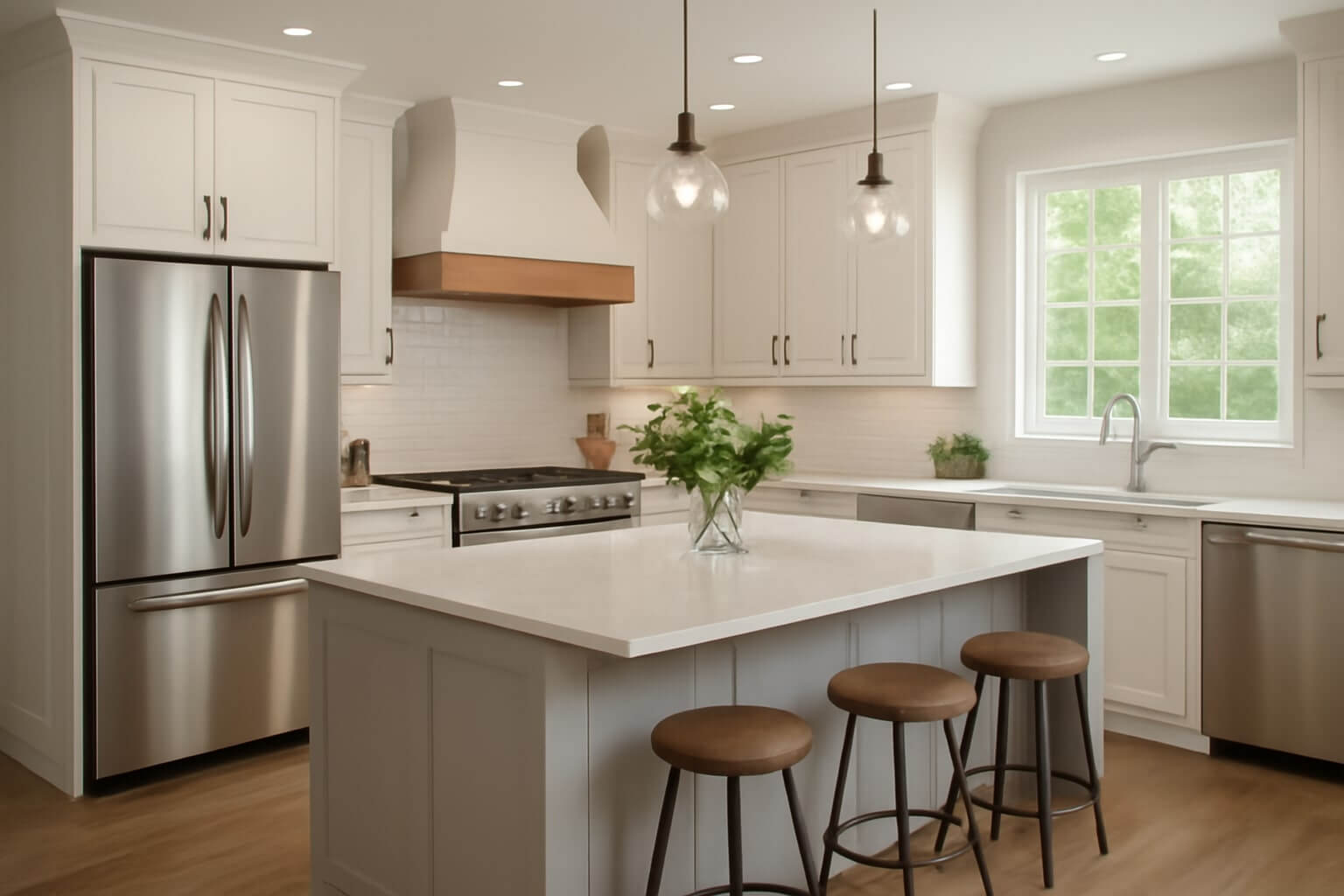When you’re planning a kitchen remodel, having a well-structured schedule template is essential. It helps you stay organized and on track throughout the project. You’ll want to break the remodel down into phases, from evaluating your current layout to enjoying your new space. Each step requires careful consideration and realistic time estimates. So, how do you begin crafting an effective timeline that accommodates all the necessary details? Let’s explore the key components.
Key Takeaways
- Define project phases clearly, including planning, demolition, plumbing/electrical, installation, and finishing touches to create a structured timeline.
- Allocate realistic time estimates for each phase, ensuring you account for potential delays and unexpected challenges.
- Set specific deadlines for each phase, allowing for regular reviews of progress against the timeline to manage expectations.
- Communicate regularly with contractors and suppliers to keep everyone informed and aligned on the project’s schedule.
- Celebrate milestones and small victories to maintain motivation throughout the remodeling process.
Assess Your Current Kitchen Layout
Have you taken a close look at your current kitchen layout? Evaluating its efficiency is essential for any remodel.
Start by reviewing how you utilize the space. Is your workflow smooth, or do you find yourself maneuvering awkwardly between appliances? Identify any dead zones where space utilization could improve.
Evaluate your kitchen workflow to pinpoint awkward movements and optimize space utilization for a more efficient cooking experience.
Consider the triangle method—positioning the stove, sink, and refrigerator close together enhances functionality.
Take measurements and note the areas that feel cramped or cluttered. This review will guide your design choices, ensuring your new kitchen meets your needs while maximizing every square inch.
A well-thought-out layout can transform your cooking experience!
Establish a Realistic Budget
Before diving into your kitchen remodel, it’s essential to establish a realistic budget that aligns with your goals and financial situation.
Start by evaluating various kitchen financing options to guarantee you can comfortably afford your vision. Use budget tracking tools to help monitor your expenses throughout the project.
Here are some key points to analyze:
- Determine your total budget limit
- Prioritize essential versus optional upgrades
- Factor in labor costs and materials
- Allocate a contingency fund for surprises
- Review and adjust your budget regularly
With a clear budget, you’ll navigate your remodel with confidence and ease.
Define Your Design Goals
To kick off your kitchen remodel, you need to define your design goals clearly.
Start by identifying the key features you want, like an island or upgraded appliances, and then determine your preferred style—whether it’s modern, rustic, or something else.
Finally, make sure to set budget parameters that align with your goals to keep the project on track.
Identify Key Features
A successful kitchen remodel starts with clearly defining your design goals.
Think about how you can improve kitchen functionality and incorporate effective storage solutions.
Here are some key features to take into account:
- Efficient layout for cooking and prep work
- Ample storage spaces, like cabinets and pantries
- Quality materials that are durable and easy to clean
- Energy-efficient appliances to save on bills
- Adequate lighting for both tasks and ambiance
Determine Style Preferences
How do you envision your dream kitchen? Start by defining your style preferences.
Are you drawn to modern aesthetics with sleek lines and minimalistic features, or do you prefer traditional elements like ornate cabinetry and classic finishes? Consider blending both styles for a unique look.
Create a vision board using images, colors, and materials that resonate with you. This will guide your decisions throughout the remodel.
Remember, your kitchen should reflect your personality and lifestyle, whether it’s a contemporary space for entertaining or a cozy area for family gatherings.
Clarity in your style will streamline the design process and enhance your satisfaction.
Set Budget Parameters
With your style preferences established, it’s time to set budget parameters that align with your design goals. Effective financial planning guarantees you stay within your budget limits while achieving a stunning remodel.
Consider these key factors:
- Research average costs for materials and labor
- Allocate a percentage for unexpected expenses (typically 10-20%)
- Prioritize essential features versus nice-to-haves
- Compare quotes from multiple contractors
- Keep track of your spending throughout the project
Research and Hire Contractors
Before diving into your kitchen remodel, you’ll want to invest time in researching and hiring the right contractors. Start by checking their qualifications, like licenses and insurance. Talk to past clients to gauge their project communication skills. Here’s a quick table to help you evaluate potential contractors:
| Contractor Name | Qualifications | Project Communication |
|---|---|---|
| Contractor A | Licensed, Insured | Excellent, Responsive |
| Contractor B | Licensed Only | Good, Average Response |
| Contractor C | Insured, References | Fair, Slow Response |
Choose wisely, as the right contractor can make all the difference in your remodel!
Develop a Detailed Timeline
To keep your kitchen remodel on track, you need to develop a detailed timeline.
Start by defining the project phases, such as demolition, installation, and finishing touches, then allocate realistic time estimates for each.
This structured approach will help you manage expectations and guarantee a smoother renovation process.
Define Project Phases
As you initiate your kitchen remodel, defining project phases is essential for creating a detailed timeline that keeps everything on track.
Start by breaking down your project into manageable stages to enhance your kitchen workflow and address storage solutions efficiently.
Here are key phases to evaluate:
- Planning: Finalize designs and gather inspiration.
- Demolition: Remove old fixtures and cabinetry.
- Plumbing and Electrical: Upgrade necessary systems.
- Installation: Set up new cabinetry, appliances, and countertops.
- Finishing Touches: Add hardware, paint, and decor.
Allocate Time Estimates
Creating a detailed timeline for your kitchen remodel involves allocating time estimates for each project phase to guarantee a smooth workflow. By doing this, you can better manage project duration and prevent delays.
Here’s a simple table to help you visualize your time allocation:
| Project Phase | Estimated Time |
|---|---|
| Design & Planning | 2 weeks |
| Demolition | 1 week |
| Installation | 3 weeks |
| Finishing Touches | 1 week |
Using this template, adjust the estimates based on your specific needs to assure a successful and timely remodel.
Select Materials and Appliances
While you might’ve a vision for your dream kitchen, selecting the right materials and appliances is essential to bringing that vision to life.
Bringing your dream kitchen to life requires careful selection of materials and appliances to match your vision.
Focus on quality and sustainability to guarantee long-lasting satisfaction. Consider these key elements:
- Sustainable materials like bamboo or recycled glass
- Energy efficient appliances that reduce utility bills
- Durable countertops, such as quartz or granite
- Timeless cabinetry styles that complement your design
- Eco-friendly flooring options, like cork or reclaimed wood
Prepare for Demolition
Before you plunge into the excitement of your kitchen remodel, it’s vital to prepare for demolition with careful planning and safety measures.
First, check local regulations to obtain the necessary demolition permits. This guarantees your project complies with building codes.
Next, gather essential safety precautions: wear protective gear like gloves, goggles, and masks, and make sure the work area is well-ventilated.
Clear out the kitchen, removing furniture and items that might get damaged.
Finally, consider disconnecting utilities like water and electricity to avoid accidents.
With these steps in place, you’ll be ready to tackle the demolition phase confidently.
Monitor Progress and Adjust Schedule
As you move through your kitchen remodel, it’s essential to track your milestones closely.
If you encounter delays, don’t hesitate to adjust your schedule promptly to stay on target. Staying flexible will help guarantee a smoother renovation experience.
Track Milestones Effectively
Tracking milestones effectively is essential for the success of your kitchen remodel, ensuring you stay on schedule and within budget. By regularly monitoring your progress, you can enhance kitchen functionality and stay aligned with design trends.
Here are some key steps to follow:
- Set specific deadlines for each phase.
- Regularly review completed tasks against your timeline.
- Adjust your schedule based on actual progress.
- Communicate with your contractors and suppliers.
- Celebrate small victories to keep motivation high.
Keeping an eye on these milestones helps you make necessary adjustments while maintaining focus on your overall vision.
Adapt to Delays Promptly
Even the best-laid plans can face unexpected hiccups during a kitchen remodel. To keep your project on track, effective delay management is crucial.
Regularly monitor progress and adjust your schedule as needed. If a supplier falls behind or unforeseen issues arise, don’t panic. Instead, utilize contingency planning to identify alternative solutions.
Maybe you can source materials from a different vendor or shift tasks around to minimize downtime. By staying flexible and proactive, you’ll not only navigate delays more smoothly but also guarantee your remodel stays as close to the original timeline as possible.
Adapt quickly, and keep your vision alive!
Final Touches and Cleanup
Once the major renovations are complete, it’s time to shift your focus to the final touches and cleanup that will bring your kitchen to life.
This stage is essential for creating a polished and inviting space. Start with final cleaning, ensuring every surface shines.
Then, add decorative accents that reflect your style. Consider:
- Installing cabinet hardware
- Hanging artwork or shelves
- Adding plants for greenery
- Placing decorative bowls or trays
- Choosing stylish window treatments
These small details make a big difference.
With everything in place, your kitchen won’t only look great but also feel like home.
Enjoy Your New Kitchen
With your kitchen now polished and adorned with personal touches, it’s time to fully embrace the space you’ve created.
Start by implementing kitchen organization tips to maximize efficiency. Utilize drawer dividers and shelf risers to keep utensils and ingredients easily accessible.
Maximize kitchen efficiency with drawer dividers and shelf risers for easy access to your utensils and ingredients.
Consider cooking space optimization strategies, like creating a designated prep area to streamline meal prep. Incorporate stylish storage solutions that complement your decor while keeping everything tidy.
Host a gathering to showcase your new kitchen, and enjoy cooking in a space designed just for you. Your hard work has paid off, so relish every moment in your beautiful new kitchen!
Conclusion
By following this kitchen remodel schedule template, you’re setting yourself up for a successful project. With careful planning, a realistic budget, and clear design goals, you can navigate each phase smoothly. Don’t forget to monitor progress and stay in touch with your contractors to address any issues that arise. Once the final touches are complete, you’ll be ready to enjoy your beautiful new kitchen, tailored to your needs and style. Happy remodeling!




